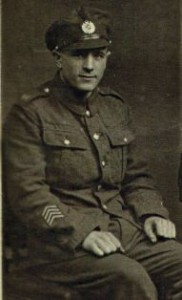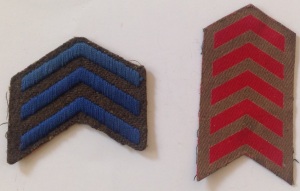During both world wars the British Army tried to come up with a way of showing on their soldiers’ uniforms those who had served overseas to distinguish them from those soldiers who remained in the UK. The way they did this was to issue small chevrons to be worn on the right sleeve above the cuff: These two examples show the differences between WW1 and WW2 chevrons:
These two examples show the differences between WW1 and WW2 chevrons: The blue chevrons are from the Great War and were first authorised in 1918, “His Majesty the King has been graciously pleased to approve of the award of chevrons to denote service overseas undertaken since 4th August 1914.” For service before December 31st 1914 a red chevron was awarded, with a blue chevron for each year after this. The army listed the following criteria for award:
The blue chevrons are from the Great War and were first authorised in 1918, “His Majesty the King has been graciously pleased to approve of the award of chevrons to denote service overseas undertaken since 4th August 1914.” For service before December 31st 1914 a red chevron was awarded, with a blue chevron for each year after this. The army listed the following criteria for award:
- the date for the award of the first chevron will be the date the individual left the United Kingdom in the case of those who proceeded from home; and the 5th August 1914 in the case of those serving abroad on that date. In the case of oversea troops the date of leaving their own country, or where employed in local operations, the date of crossing the frontier or that on which they commenced to take part in active operations.
- Additional chevrons will be awarded for each successive aggregate period of 12 months’ service outside the United Kingdom; the case of overeat troops, away from their own country or within a sphere of active operations.
- The qualifying service for additional chevrons need not be continuous. It will include periods of leave up to one month where the individual returns overseas at the conclusion of such leave.
- Periods of absence without leave, in prison or detention, in hospital due to sickness due to avoidable causes, or in captivity as a prisoner of war, will be excluded when calculating the twelve months required to qualify for an additional chevron.
- Draft conducting officers and others sent overseas on duty of a temporary nature … are not eligible for the award.
The act went on to say:
The chevrons may be worn in plain clothes by retired officers, ex-officers, pensioners, ex-soldiers and others who would, had they remained in the service or continued in any of the employments detailed above, have been entitled to wear them on uniform clothing, should they wish to do so, but no issue shall be made from government stores”.
“It is an offence under the Defence of the Realm Regulations for any unauthorised person to wear a chevrons or chevrons”.
“There will be no posthumous award to deceased officers or soldiers”.
Official wear of the chevrons was discontinued in 1922, but they were reintroduced in a different form in WW2 with small red chevrons (see above) replacing the earlier blue examples. Each chevron represented one year’s service abroad after 3rd September 1939. As can be seen the WW1 example is embroidered and the WW2 one printed: This seems to be the most common way to find these chevrons, but embroidered WW2 examples are known to exist. It appears that these chevrons were often not worn by those entitled to them and do not seem to have been as popular as most insignia used to distinguish ‘old hands’.
This seems to be the most common way to find these chevrons, but embroidered WW2 examples are known to exist. It appears that these chevrons were often not worn by those entitled to them and do not seem to have been as popular as most insignia used to distinguish ‘old hands’.
[…] Overseas Service Chevrons in Tales from the Supply […]